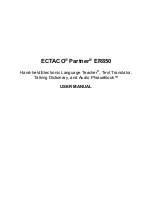
330
The TRITON Extreme can use packet writing to write to a
CD-R/RW of the USB device.
After formatting the media, you can use it in the same way
as CompactFlash or a hard drive.
■
About packet writing
Packet writing is a method of dividing data into small units
called “packets” so that the data can be written efficiently,
and is suitable for adding or updating data.
As its packet writing format, the TRITON Extreme uses UDF
(Universal Disk Format), the format that is also used on
DVD discs. This means that formatted CD-R/RW media can
also be read by packet writing software that supports UDF.
The TRITON Extreme supports UDF version 1.5.
■
Usable media
To save data, please use media that has been formatted
by the TRITON Extreme.
• 650 MB and 700 MB CD-R media that supports up to 16
×
writing
• 650 MB and 700 MB CD-RW media that supports up to
4
×
/10
×
writing
■
Formatting
In the same way as when formatting, insert blank or previ-
ously-formatted media into the drive, and execute the page
menu command “Format” (Media Utility 0–3F).
Cautions when formatting
[1] For a CD-R
• Data that has been written to CD-R cannot be erased as it
can on a CompactFlash. This means that re-formatting
previously-formatted media will not increase the free
area. (Approximately 20 MB of space will be used to add
a new session.)
• Only Quick Format can be selected.
Quick Format requires less than a minute to execute.
[2] For a CD-RW
• A CD-RW can be formatted to erase the previously-
written contents. This means that re-formatting the disc
will increase the free area.
• Quick Format: Select this if the media has already been
formatted in UDF format.
Full Format:
Select this if the media is blank or if it has
not been formatted in UDF format.
You should also execute this type of formatting if fre-
quent writing errors occur when writing to the media.
Quick Format will require several minutes for comple-
tion, while Full Format will require between several tens
of minutes to several hours (depending on the device).
• After formatting, the usable area for 650 MB/700 MB
media will be approximately 530 MB/570 MB respectively.
■
Cautions when using packet writing
[1] For a CD-R
Deleting a file merely makes the file appear as if it had
been deleted, and will not increase the free area. Also,
each time a file is updated, a new file is added, and pro-
cessing is performed to make it appear as though the file
had been overwritten.
[2] For a CD-RW
Deleting a file will increase the free area. Also, updating a
file will overwrite the file over the previous location.
[3] About writing data
Using packet writing to save data on a CD-R/RW will
take a longer time because writing to CD-R/RW is
slower than writing to hard disk. The time will also
depend on the CD-R/RW drive you use, and on the writ-
ing speed supported by the media you use.
■
Loading into an external device
other than the TRITON Extreme
[1] For a CD-R
• The disc can be read by a computer on which packet
writing software is installed.
• By converting it into ISO9660 format, you can make it
possible for the data to be read by an external MIDI
device that supports ISO9660 format, or by a computer
on which packet writing software has not been installed.
For details on the conversion, refer to page menu
command “Convert to ISO9660 Format” (Media Utility
0–3G).
[2] For a CD-RW
• The disc can be read by a computer on which UDF
reader or packet writing software has been installed.
• This disc cannot be converted into ISO9660 format, and
therefore cannot be read by external MIDI devices that
support ISO9660 format.
Since the conversion to ISO9660 format adds ISO9660
session data, it consumes approximately 20 MB of space.
External MIDI devices that support ISO9660 format (*1)
(manufactured by Korg Corporation)
• TRITON Extreme/TRITON STUDIO/TRITON/TRITON
pro/TRITON proX/TRITON-Rack (*2)
• Korg Digital Recording Studio series D16 and later
models
* As of September 2003
*1: Supports ISO9660 level 1.
*2: Only the first session can be read.
When you copy a file larger than 1.9 Mbytes from CD-
R/RW (or other media with a slow access speed) to CD-
R, the file may not be copied in a continuous state.
Also, when you execute “Rate Convert” (Global 0–3G),
“Save to Std MIDI File” (Media 0–2F) or similar com-
mand to save to CD-R, the file may not be written in a
continuous state even if it is copied from media with a
fast access speed such as hard disk. If data in this state
is converted into ISO9660 format, it will be in the
divided file format supported by ISO9660 level 3.
Packet writing support on the
TRITON Extreme
Summary of Contents for TRITON Extreme
Page 1: ...2 E ...
Page 11: ...xii ...
Page 111: ...100 9 5 Page Menu Command 0 1A 0 1I 0 1J Program 9 5A ...
Page 185: ...174 ...
Page 215: ...204 ...
Page 281: ...270 ...
Page 349: ...338 ...
Page 350: ...339 ...
Page 351: ...340 ...
Page 352: ...341 ...
Page 353: ...342 ...














































